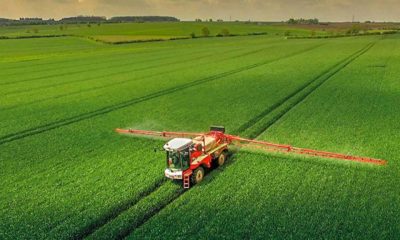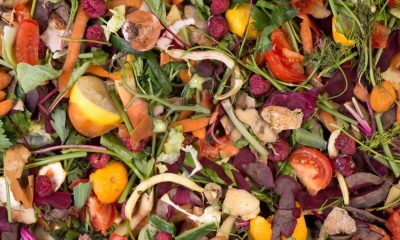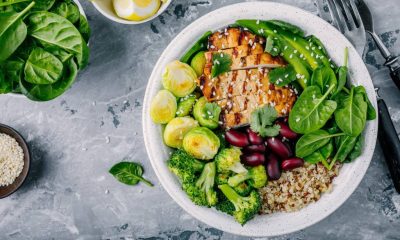Lifestyle
Backpack Essentials for Returning to School

As the new school year approaches, students everywhere are getting ready to head back to the classroom. Among the many preparations, ensuring that your backpack is properly stocked with all the essentials is key to starting the year off right. A well-packed backpack not only keeps you organized but also helps you be prepared for whatever the school day might throw your way. Whether you’re starting a new grade, returning after a break, or just looking to optimize your routine, knowing what to pack can make all the difference.
Academic Supplies: The Basics and Beyond
The foundation of any good backpack begins with academic supplies. Notebooks, pens, pencils, and erasers are the obvious necessities, but it’s worth considering some additional items that can enhance your study sessions. Highlighters are great for emphasizing key points in your notes or textbooks, while sticky notes can help you mark important pages or jot down quick reminders.
A reliable calculator is another must-have, especially for students tackling math or science courses. Depending on your level, a scientific or graphing calculator might be required. Make sure to check with your school or teacher about the specific model you’ll need. Additionally, a sturdy folder or binder can keep your papers organized and prevent them from getting crumpled or lost in the depths of your backpack.
It’s also a good idea to have a small pencil case to keep all your writing utensils in one place. This not only helps with organization but also ensures that you’re never scrambling to find a pen during class. Keeping your academic supplies well-organized will help you stay on top of your schoolwork and reduce stress throughout the year.

Technology: Staying Connected and Productive
In today’s digital age, technology has become an integral part of the learning experience. Packing the right tech tools can make a significant difference in your productivity and ability to complete assignments on the go. A lightweight laptop or tablet is a great addition to your backpack, allowing you to take notes, access online resources, and complete assignments from anywhere. If your school provides devices, make sure you have a protective case to keep it safe.
Don’t forget to pack a charger or a portable power bank to ensure your devices stay charged throughout the day. This can be a lifesaver, especially during long days at school or if you have after-school activities. Headphones or earbuds are another essential, particularly if you need to focus while studying or listen to online lectures.
A USB drive can be useful for transferring files between school computers and your personal devices, especially if you’re working on group projects or need to print assignments at school. Ensuring that your tech gear is ready and protected will help you stay connected and efficient as you tackle your schoolwork.
Health and Hygiene: Staying Clean and Comfortable
Staying healthy and comfortable throughout the school day is just as important as being prepared academically. Including a few health and hygiene items in your backpack can help you feel your best, no matter what the day brings. Hand sanitizer and disinfecting wipes are essential for keeping germs at bay, especially in high-traffic areas like classrooms and cafeterias.
A small pack of tissues is also useful for those unexpected moments when you need them. If you wear braces, glasses, or contact lenses, make sure to include any necessary supplies like a braces kit, lens cleaner, or extra contact lenses. Lip balm and hand lotion can be lifesavers during colder months when your skin might become dry.
Hydration is key to staying focused, so packing a reusable water bottle is a must. Staying hydrated helps maintain energy levels and concentration throughout the day. Additionally, keeping a few healthy snacks in your backpack can help you power through long days or provide a quick boost before after-school activities.
Being mindful of your health and hygiene will help you stay comfortable and focused, allowing you to make the most of your school day.
Personal Organization: Keeping Everything in Order
Personal organization is the glue that holds all your school essentials together. A planner or agenda is crucial for keeping track of assignments, tests, and extracurricular activities. Writing down your schedule not only helps you stay on top of deadlines but also reduces the chances of forgetting important tasks.
Consider using color-coded folders or tabs to separate your work by subject, making it easier to find what you need quickly. This system can save you time and help keep your backpack organized. For younger students, a labeled folder for homework and permission slips can be particularly useful, ensuring that important papers make it home and back to school.
If your school allows it, a small portable whiteboard or notebook for to-do lists can be a helpful addition, giving you a space to jot down quick reminders or ideas. Keeping your backpack tidy and well-organized will make your daily routine smoother and help you stay focused on learning.
Conclusion
Preparing your backpack for the school year ahead is more than just gathering supplies; it’s about equipping yourself for success. From academic essentials to technology, health items, and personal organization tools, each component plays a crucial role in ensuring you’re ready to take on the challenges of the school day. By thoughtfully packing and organizing your backpack, you set yourself up for a productive, healthy, and enjoyable school year. For more tips on school preparation and to explore a range of essential supplies, visit our website and get ready to start the year off right. Being prepared means more than just having the right items—it’s about feeling confident and ready to learn, grow, and succeed in the year ahead.
Lifestyle
The Evolving Fabric of Society: Navigating Change in the 21st Century

Society is not a static structure — it is a living, evolving network of relationships, values, institutions, and cultural expressions that reflect the time and context in which people live. As we progress further into the 21st century, the rapid pace of technological advancement, cultural exchange, and global events has reshaped how we connect, communicate, and coexist.
This evolution brings both opportunities and challenges. From shifts in family dynamics and education to the role of technology and civic engagement, today’s society is a complex ecosystem that demands reflection, adaptation, and inclusive participation. In this article, we explore key trends shaping society today and how individuals and communities can respond to ensure a more equitable and cohesive future.
The Changing Nature of Community
Traditionally, community was defined by geography — neighborhoods, towns, or villages where people lived and interacted face-to-face. But in today’s world, community has expanded to include digital spaces, interest-based groups, and global networks. While this expansion has opened doors to diversity and collaboration, it has also created new challenges around identity, isolation, and trust.
Many people now form relationships through online platforms, social media groups, and virtual events. These communities offer incredible opportunities for support and learning but can also lead to echo chambers, misinformation, and a weakening of local engagement.
Rebuilding meaningful connection requires balancing digital and physical interaction. Local initiatives — from community gardens to neighborhood events — play a critical role in strengthening civic ties and building resilience in the face of global uncertainty.
Technology and Society: Double-Edged Innovation
Technology has dramatically transformed how society functions. From smartphones and AI to social media and digital finance, these tools have made information, communication, and services more accessible than ever before. But while technology offers convenience and efficiency, it also raises ethical, social, and economic questions.

On one hand, tech has democratized knowledge, given marginalized groups a voice, and enabled global collaboration. On the other, it has fueled privacy concerns, digital addiction, and job displacement due to automation.
As artificial intelligence, facial recognition, and biotechnology continue to advance, society must actively engage in discussions about data rights, surveillance, algorithmic bias, and digital literacy. Citizens, educators, and policymakers need to ensure that technological progress aligns with human values and social equity.
Education and Equity in Modern Society
Access to quality education remains a cornerstone of a thriving society. Yet disparities in education continue to mirror broader inequalities — influenced by income, race, geography, and political will. The COVID-19 pandemic exposed and deepened many of these educational gaps, with millions of students facing challenges in remote learning due to lack of devices, internet access, or support systems.
Modern society must embrace inclusive and adaptive education systems that prepare students not only with academic skills but also with emotional intelligence, critical thinking, and global awareness. Programs that support early childhood education, vocational training, and adult learning are essential for lifelong development and economic participation.
Efforts to reform curricula to reflect cultural diversity, social justice, and sustainability are also gaining momentum. Education must evolve to meet the realities of our interconnected, diverse, and rapidly changing world.
The Role of Media and Public Discourse
Media — both traditional and digital — plays a powerful role in shaping public opinion, cultural norms, and political discourse. In a world flooded with information, media literacy has become essential to distinguish credible sources from misinformation and propaganda.
While social media platforms have empowered citizens to share their voices and mobilize for causes, they have also contributed to the polarization of society, with algorithm-driven content often reinforcing existing biases.
Responsible journalism, transparent fact-checking, and public education about digital citizenship are crucial to preserving a healthy, informed society. Open dialogue, civil debate, and the protection of press freedom remain vital for democratic societies.
Civic Engagement and Social Movements
One of the most encouraging trends in contemporary society is the rise of grassroots activism and civic engagement. Movements like Black Lives Matter, climate strikes, women’s marches, and campaigns for LGBTQ+ rights have galvanized millions, especially youth, to participate in the democratic process and demand social change.
These movements underscore the importance of representation, equity, and justice. They also highlight the need for structural reform in areas such as policing, healthcare, environmental policy, and voting rights.
In an era where trust in institutions is declining, restoring faith in governance and civil society requires transparency, accountability, and inclusive participation. Education, open government initiatives, and accessible civic platforms can empower more people to engage with the systems that shape their lives.
Diversity, Inclusion, and Social Cohesion
Modern societies are increasingly multicultural, multilingual, and multiethnic. Embracing this diversity requires more than just tolerance — it calls for active inclusion, equal opportunity, and the dismantling of systemic barriers that prevent full participation.
Workplaces, schools, and public institutions are gradually adopting diversity and inclusion initiatives that recognize the value of different perspectives and experiences. This is not only ethically important but also contributes to innovation, productivity, and social cohesion.
However, inclusion must go beyond corporate checklists or superficial representation. It must involve anti-discrimination policies, cultural sensitivity training, equitable hiring practices, and support for marginalized communities.
Mental Health and the Social Fabric
As mental health challenges rise across age groups, particularly among youth and working adults, society is being forced to confront the emotional well-being of its members. Social isolation, economic pressure, and the relentless pace of modern life contribute to widespread anxiety, depression, and burnout.
Removing stigma around mental health and ensuring access to care are essential. Schools, employers, and communities must promote mental wellness as part of overall health, investing in counseling, support systems, and awareness programs.
A healthy society is one where empathy, understanding, and support are prioritized, not just for physical needs but also for emotional resilience.
The Climate Crisis: A Collective Responsibility
No discussion about modern society is complete without acknowledging the climate crisis. Environmental degradation, extreme weather, and resource depletion pose existential threats not just to ecosystems but to the very foundations of civilization.
Society must transition toward sustainability, rethinking consumption, energy use, and waste management. This includes promoting renewable energy, sustainable agriculture, and conservation efforts, as well as educating citizens about climate action.

Individuals, governments, and businesses all have a role to play in creating a society that respects the planet and prioritizes long-term ecological balance.
Conclusion: Building a Society for the Future
Today’s society is a mosaic of challenges and possibilities. From technological innovation and demographic shifts to political activism and cultural diversity, we are living in a time of profound transformation.
To navigate this complexity, we must embrace collaboration, empathy, and critical thinking. We need inclusive policies, resilient communities, and education that empowers people to adapt and lead.
Above all, we must remember that a strong society is not defined by its economy or institutions alone — but by how it treats its people, protects its planet, and prepares for the generations to come.
Lifestyle
The Changing Fabric of Society: How Communities Are Adapting in a Modern World

Society is constantly evolving. What defines a community—its values, traditions, and ways of connecting—rarely stays the same for long. Driven by technology, cultural shifts, and global challenges, today’s social landscape looks dramatically different from that of just a few decades ago. As digital platforms reshape communication, workplaces become more flexible, and people rethink their priorities, the question arises: how do we build strong, connected societies in an era of rapid change?
The answer lies in understanding the forces shaping our communities and learning how to adapt while preserving the bonds that hold us together.
Technology: The Double-Edged Sword of Connection
Technology is one of the most powerful forces redefining modern society. Social media and digital communication allow us to stay connected across continents, share ideas instantly, and amplify voices that might otherwise go unheard. Online platforms have given rise to movements for social change, new forms of education, and opportunities for collaboration that transcend borders.
However, this hyper-connectivity also comes with challenges. While people are more “connected” than ever, studies show that feelings of loneliness and social isolation are rising. Digital interactions often lack the depth of face-to-face connections, and the constant exposure to curated online lives can lead to anxiety, comparison, and polarization.
To build healthier societies, individuals and communities must strike a balance—embracing technology as a tool for connection and progress while prioritizing genuine, in-person interactions and fostering empathy in digital spaces.
Changing Work and Community Dynamics
The way people work—and by extension, the way they relate to their communities—is shifting dramatically. Remote and hybrid work models, accelerated by the COVID-19 pandemic, have altered traditional notions of the workplace. While these changes offer flexibility and better work-life balance for many, they can also weaken the sense of camaraderie and shared purpose once found in physical workplaces.

Communities are adapting by finding new ways to connect outside of work. Local events, co-working spaces, and hobby-based groups help fill the social gap created by remote work. These spaces not only combat isolation but also strengthen local economies and cultural ties.
Society is also grappling with questions about work-life balance, equity, and access. Flexible schedules and digital tools create opportunities for many, but they can also deepen inequalities if access to technology and remote work benefits isn’t evenly distributed. Addressing these disparities is critical to maintaining a cohesive, fair society.
Diversity and Inclusion: Building Stronger Communities
Modern societies are more diverse than ever before, encompassing a wide range of cultures, languages, and perspectives. This diversity is a source of strength, fostering creativity, innovation, and resilience. Communities that embrace inclusivity tend to thrive, benefiting from the exchange of ideas and experiences.
However, diversity also brings challenges, particularly when it comes to fostering understanding and combating discrimination. Education, open dialogue, and community-led initiatives are key to bridging cultural divides. By promoting empathy and ensuring equal opportunities, societies can transform diversity from a challenge into a powerful driver of unity and growth.
The Role of Mental Health in Society
Mental health, once a taboo topic, has become a central concern in conversations about societal well-being. Rising rates of anxiety, depression, and burnout highlight the importance of emotional resilience and access to support systems.
Communities are beginning to recognize that strong societies aren’t just built on economic or physical health—they also depend on the mental well-being of their members. Schools, workplaces, and local organizations are incorporating mental health education, counseling services, and mindfulness practices to create environments where individuals can thrive emotionally as well as socially.
Addressing mental health collectively not only supports individuals but also strengthens the overall fabric of society, fostering compassion and understanding across communities.
Environmental Awareness and Social Responsibility
Climate change and environmental concerns are uniting communities around shared goals. More individuals are recognizing the societal impacts of environmental degradation—ranging from economic instability to health crises—and are working together to create sustainable solutions.
Local initiatives like community gardens, recycling programs, and clean-energy projects are bringing people together while promoting environmental responsibility. On a global scale, movements advocating for sustainability and corporate accountability are gaining traction, proving that collective action can spark meaningful change.
These initiatives also highlight an important shift in societal values: a growing recognition that individual actions contribute to a collective future, and that true progress must balance human needs with environmental stewardship.
Rebuilding Social Bonds in an Age of Division
Despite growing awareness and collective efforts, many societies are grappling with division—political polarization, cultural conflicts, and economic disparities. These fractures can weaken trust and make it harder for communities to work toward shared goals.
Rebuilding social bonds requires intentional action. Promoting dialogue across differences, supporting local initiatives that bring people together, and prioritizing shared values like fairness, empathy, and respect can help bridge divides. Volunteering, civic engagement, and cultural exchanges all provide pathways for strengthening trust and understanding.
Ultimately, strong societies are built not by erasing differences but by finding common ground and learning to value diverse perspectives.

The Future of Society: Adapting and Thriving
As societies continue to evolve, flexibility and innovation will be crucial. Future communities are likely to be shaped by:
-
Hybrid lifestyles, blending digital and in-person interactions to maximize convenience and connection.
-
Greater focus on well-being, with mental and physical health prioritized alongside economic growth.
-
Localism and globalism coexisting, as communities support local businesses and traditions while staying connected to global networks.
-
Youth-driven change, as younger generations push for inclusivity, sustainability, and new models of governance and engagement.
These trends suggest that while society faces significant challenges, it also has unprecedented opportunities to build stronger, more resilient communities.
Conclusion: Shaping Society Together
Society is not a static entity—it’s a living, breathing system shaped by the choices, values, and actions of its members. In an era defined by technological advancement, cultural shifts, and global challenges, the task of building connected, resilient communities falls to all of us.
By embracing diversity, prioritizing mental health, using technology responsibly, and fostering genuine human connections, we can create societies that not only withstand change but thrive because of it. The future of society depends on our ability to come together—not as isolated individuals, but as active, compassionate members of a shared world.
Lifestyle
The Changing Fabric of Modern Society: Navigating Connection, Identity, and Responsibility in the 21st Century

In the 21st century, society is evolving faster than ever before. Technological advancement, cultural diversity, shifting family structures, and new definitions of work and community are transforming how people live, interact, and understand themselves. The modern world has blurred traditional boundaries — between online and offline life, private and public space, and even between individual and collective responsibility. As we navigate this complex landscape, it’s crucial to understand the forces shaping today’s social fabric and the implications for human connection, identity, and shared responsibility.
1. The Age of Digital Connection — and Disconnection
Technology has revolutionized communication. In a single decade, social media, smartphones, and instant messaging have become the main modes of interaction for billions of people. Platforms such as X (formerly Twitter), Instagram, and TikTok shape not only how people communicate but also how they perceive reality. The digital world allows for global dialogue — individuals from opposite sides of the planet can connect instantly, exchange ideas, and even collaborate on social causes.
However, the paradox of this connectivity is evident. While digital platforms bring people closer in theory, they can also isolate individuals emotionally. Online echo chambers amplify divisions, misinformation spreads faster than ever, and the pressure of maintaining a curated digital identity often leads to stress and anxiety. Many sociologists argue that while society is more connected than ever technologically, genuine human connection is declining. The challenge ahead lies in finding balance — using technology as a tool for unity, rather than as a source of division or detachment.
2. The Redefinition of Identity in a Globalized World
Globalization has reshaped how people think about identity. National, cultural, and personal boundaries are increasingly fluid. Migration, multiculturalism, and digital media have exposed individuals to an array of perspectives, traditions, and lifestyles. For many, this offers freedom — the ability to define oneself beyond geography or convention.
Yet, this freedom can also create confusion. In a world where everything is connected, individuals often struggle to find a stable sense of belonging. Questions of identity — who we are, what we believe, and where we belong — have become central social issues. Movements advocating for gender equality, racial justice, and LGBTQ+ rights have grown stronger, reflecting society’s ongoing efforts to embrace inclusivity and self-expression.
At the same time, backlash and polarization also arise when groups feel their traditional values are being challenged. The tension between progress and preservation has become one of the defining features of modern societies. Navigating this requires empathy, dialogue, and education — tools that can bridge divides rather than deepen them.

3. Work, Economy, and the New Social Order
The structure of work has undergone a dramatic shift. The rise of the gig economy, remote work, and automation has altered not only how people earn a living but also how they define purpose and success. In the past, stable jobs and long-term careers formed the backbone of many societies, giving individuals a clear social role and sense of identity.
Today, flexibility, independence, and innovation are valued — but they come at a cost. Many workers face insecurity, irregular income, and the erosion of traditional labor rights. Society must adapt to ensure that technological progress does not leave people behind. Concepts like universal basic income, lifelong education, and the four-day workweek are being debated worldwide as potential solutions to modern economic instability.
Moreover, as artificial intelligence and automation expand, societies must redefine what it means to contribute. If machines handle most tasks, the human role may shift toward creativity, empathy, and social care — qualities that technology cannot replicate. A healthy future society will need to balance efficiency with humanity.
4. The Shifting Dynamics of Family and Community
Family, once considered the cornerstone of society, is evolving in structure and definition. Traditional nuclear families now exist alongside single-parent households, blended families, same-sex couples, and child-free lifestyles. This diversity reflects changing social values — greater acceptance, gender equality, and individual freedom.
However, it also raises questions about support systems. As people live more independently, the role of community becomes increasingly vital. In many urban areas, loneliness and social isolation are rising, particularly among older adults and young professionals. Community programs, local engagement, and intergenerational initiatives are essential to rebuilding the sense of collective belonging that industrialized societies often lose.
Interestingly, digital communities are emerging as new forms of belonging. Online support groups, forums, and shared-interest spaces often substitute for physical neighborhoods. While these can be positive, they also need to be approached critically, ensuring they promote empathy and constructive dialogue rather than hostility or misinformation.
5. Social Responsibility in the Age of Global Challenges
The 21st century has also ushered in new global responsibilities. Issues like climate change, migration, and inequality are no longer confined to national borders. The pandemic underscored how deeply interconnected humanity is — and how the actions of individuals can have worldwide consequences.
As awareness grows, citizens and corporations alike are being called to act responsibly. Sustainable living, ethical consumerism, and corporate social responsibility are becoming central social values. Younger generations, in particular, are driving this transformation. Surveys show that Gen Z and Millennials prioritize social justice, environmental protection, and mental well-being more than previous generations.
However, activism alone is not enough. Structural change requires cooperation between governments, businesses, and communities. A socially responsible future depends on collective participation — recognizing that every individual’s choices contribute to the broader human ecosystem.
6. Education and the Rise of Social Awareness
Education remains one of society’s most powerful tools for change. Modern education extends beyond academic achievement — it now encompasses emotional intelligence, cultural literacy, and ethical awareness. Schools and universities are increasingly tasked with preparing students not only for jobs but for citizenship in a diverse, global world.
Digital literacy, for example, is essential to combat misinformation and promote critical thinking. Likewise, social and emotional learning helps individuals navigate complex interpersonal dynamics and build resilience. The education system’s role in shaping responsible, informed citizens is more critical now than ever before.

7. The Future of Society — Building Connection and Purpose
Looking ahead, society stands at a crossroads. The next decades will determine whether technology, globalization, and diversity strengthen our collective humanity or erode it. To build a thriving social future, three principles will be key: empathy, adaptability, and shared purpose.
Empathy helps bridge cultural and ideological divides. Adaptability allows communities to embrace change without losing their essence. And shared purpose — the belief that we are working toward something greater than ourselves — restores meaning in an increasingly complex world.
In essence, the story of modern society is one of transformation. Every generation faces its unique challenges, but the current era offers unprecedented opportunities for progress and understanding. If we can harness the tools of connection wisely, respect the richness of diversity, and uphold our collective responsibility, the 21st century may well become not just an age of change — but an age of shared human growth.
-

 Technology2 years ago
Technology2 years agoNew Agriculture Technology in Modern Farming
-

 Food2 years ago
Food2 years agoFighting Restaurant Food Waste with Technology
-

 Education1 year ago
Education1 year agoTips To Support Underserved Students
-

 Food1 year ago
Food1 year agoHow to Get Enough Protein Without Meat
-

 Education2 years ago
Education2 years agoInnovative Learning Strategies for the Digital Age
-

 Fitness1 year ago
Fitness1 year agoFueling Your Body for Optimal Performance
-

 Fitness1 year ago
Fitness1 year agoEffective Appetite Control for Enhanced Fitness Results
-

 Food1 year ago
Food1 year agoThe Role of Macronutrients in a Balanced Diet





